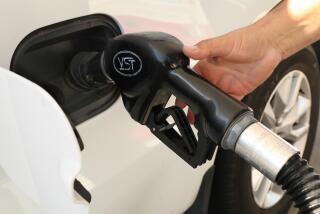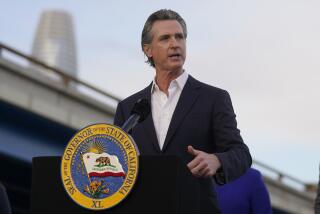Drivers’ Ideas to Save on Gas Are Getting Plenty of Mileage
- Share via
As gasoline prices hit a new record in Southern California on Monday, each customer at the USA Gasoline station on Peck Road in El Monte seemed to have his own strategy for dealing with the rising costs.
Raymond Valenzuela keeps his air conditioning off, instead rolling down the windows of his burgundy Plymouth Acclaim. The 32-year-old machine operator also avoids gas stations near freeways, which he believes charge more, and sometimes fills up at night because a friend told him pumps deliver more gas when temperatures are cool.
Brian Edwards, a 50-year-old tire deliveryman, religiously checks the tire pressure on his Ford Aerostar minivan.
A few miles away at an Exxon station, John Myung, a 49-year-old importer, makes sure to fill up his Lexus 430 during the week, believing that gas stations jack up prices on the weekend.
In the quest to squeeze as much mileage out of their gas budgets as possible, motorists are exploring all the angles, gleaned from friends, family and even the Internet. Some work; others are urban myths.
Turning off the air conditioning and opening the windows, for example, actually lessens fuel economy because air going through the windows adds drag to the car.
Myung is not alone in thinking gas prices go up on weekends, but experts say he’s wrong.
“That’s a bit of an old wives’ tale, a myth,” said Tom Kloza, chief oil analyst for the Oil Price Information Service. “Wholesale prices change every day, with the exception of Sunday. The biggest price moves tend to take place on the wholesale markets on Wednesdays these days.”
But there does appear to be truth to the theory that stations near freeways charge more.
“There’s substantial premiums you pay if you buy gas near a freeway,” said Michael Shames, executive director of the Utility Consumers’ Action Network, a San Diego group that has tracked regional gasoline prices. “It’s simply a function of gas stations’ taking advantage of the convenience factor. They may also pay higher rents, though.”
How about driving behind a big rig? That also can improve fuel economy.
“It’s the same theory that Lance Armstrong exploits whenever he’s riding in the Tour de France,” Shames said. “He’s taking advantage of the draft created by other riders to reduce the amount of effort he has to make.”
However, experts don’t recommend the technique for motorists because of the dangers of being in the trucker’s blind spot.
Keeping a vehicle’s tires properly inflated improves fuel economy. That’s because underinflated tires require more energy to roll. They can reduce fuel economy up to 2% for each pound of tire pressure below the recommended level, according to the Automobile Club of Southern California.
There’s always money to be saved by taking the train for longer commutes, right?
Not necessarily. A 70-mile round trip commute from Santa Clarita to downtown Los Angeles would cost $7 to $8 in fuel. The same trip costs $12 on Metrolink.
Even with the average price for a gallon of regular now at $2.71 and premium grades going for more than $3, most drivers aren’t in a position to stop using their cars.
So they are responding in much the way they try to lose weight -- with complex special diets, instead of by simply eating less and exercising more, Kloza said.
“It’s like that scene in ‘Goodfellas,’ where one of the guys says, ‘How come this food tastes so good?’ ‘Because it’s stolen,’ ” Kloza quoted.
“When people save money on gasoline, it gives them an immediate sunny countenance. They think they pulled the wool on somebody.”
Some of the tactics adopted by beleaguered commuters make perfect sense.
Instead of gunning the engine when leaving a stoplight and darting in and out of traffic, drivers should take it easy on the accelerator and maintain a steady speed, said Jeffrey Spring, a spokesman for the Automobile Club.
A recent study showed that a driver with a heavier foot got only nine miles a gallon, but when he slowed down, he got 20 miles a gallon, Spring said.
“We encourage people to drive with the speed of traffic instead of trying to beat everyone on the road,” he said. “You can save a lot of gas that way.”
How about removing that ski rack or bike rack from the vehicle roof? Experts said that would improve fuel economy by making the car more aerodynamic.
But other notions simply aren’t backed up by the facts.
“Gasoline prices are kind of like a festering scab for people,” Kloza said. “People do odd things regardless of how stupid it is.”
Many people believe that purchasing a higher-octane gas, for instance an 89 grade instead of an 87 grade, will improve fuel efficiency.
“That’s a myth. There’s almost no justification I’ve found for anybody to use the medium grade, 89 octane,” Shames said. “There are some cars that are designed to run on 92 octane grade, but otherwise I recommend using regular unleaded.”
Although commuters have different theories about why gas prices vary from station to station, the main reason is something known as “zone pricing,” an oil company strategy to boost profits by charging dealers different amounts for fuel based on traffic volume, station amenities, nearby household incomes, the strength of competitors and other factors.
The presence of a big-box retailer such as Costco or Sam’s Club could contribute to cheaper gasoline in a neighborhood because it forces the hands of competitors.
“Their model is not based on making money on gasoline,” Kloza said of the discount chains. “It’s based on getting you into the store to buy other items.”
The gas price hike has some drivers purchasing devices that claim to reduce consumption. The Auto Club tested many of the gadgets, including one that involves magnets placed on the outside of a vehicle and a fan-like contraption -- both supposedly designed to boost fuel flow.
“They don’t work, as far as we can tell,” Spring said. “I would say don’t waste your money buying devices to improve your fuel economy. Clean out the junk in your trunk instead.”
What about Valenzuela’s belief that he’s getting more gasoline by filling up at night when it’s cool?
Experts said he’s actually right about that one -- sort of.
Gasoline molecules are packed more densely when the temperature is colder. But Kloza said today’s pump meters are designed so any difference between filling up by day or by night is negligible.
“You’d have to buy an awful lot of fuel to see a difference,” he said. “But there is some truth to that.”
Back at the gas station on Peck Road, Edwards and the other drivers vow to keep their gas-saving rituals going.
“You have to give up something for something,” said Edwards, sweating a bit as he proudly discussed his decision to keep the air conditioner off.
“If you want more mileage, you have to get a little more uncomfortable, I guess.”
*
Times staff writer Wendy Lee contributed to this report.
*
(BEGIN TEXT OF INFOBOX)
Myths and truths
Belief: Driving close behind a truck improves gas mileage because the truck cuts your wind resistance.
Reality: True, but it’s also dangerous.
Belief: Gasoline stations near freeway exits charge higher prices.
Reality: Generally true.
Belief: You get more for your money if you fill up when it’s cold because gasoline is denser at low temperatures.
Reality: Not really. Any difference would be insignificant and besides, most pumps correct for temperature.
Belief: Turning off the air conditioning saves gas.
Reality: True, but if you then roll down the windows, the increased wind resistance may eat up any savings.
Belief: Gas prices go up on the weekend, so fill up during the week.
Reality: Generally false.
Source: Times reporting
Los Angeles Times







